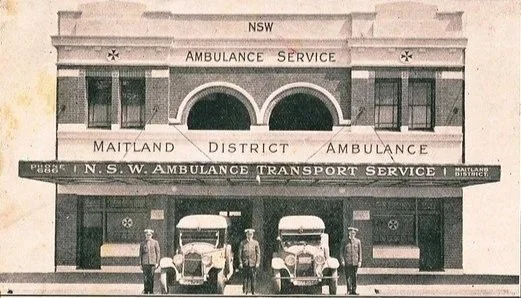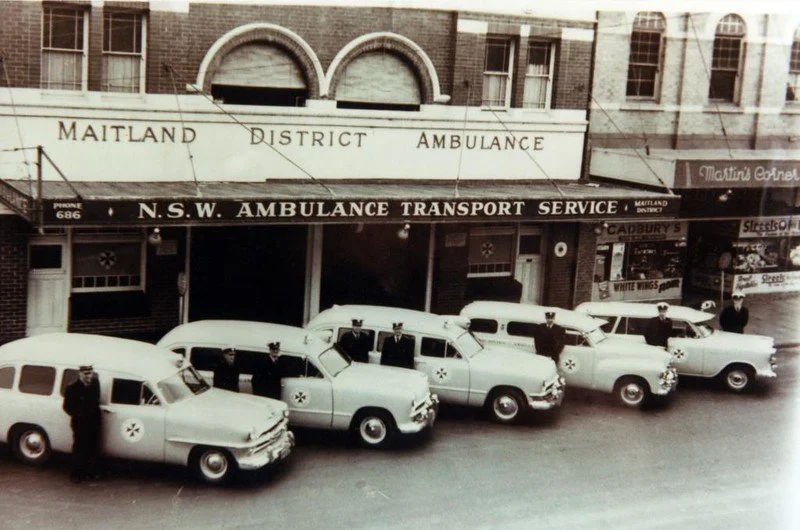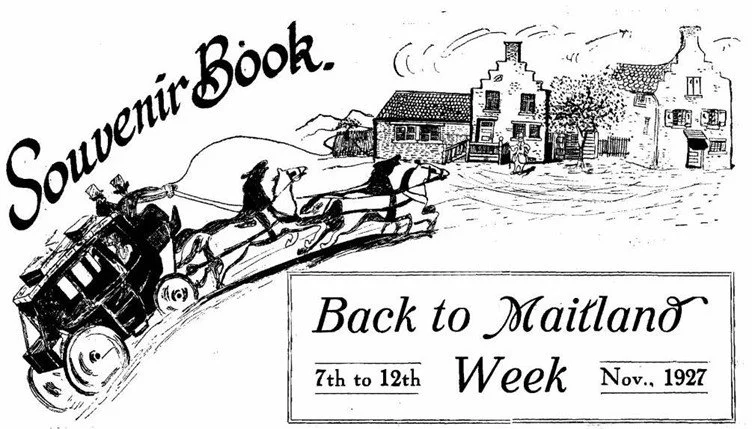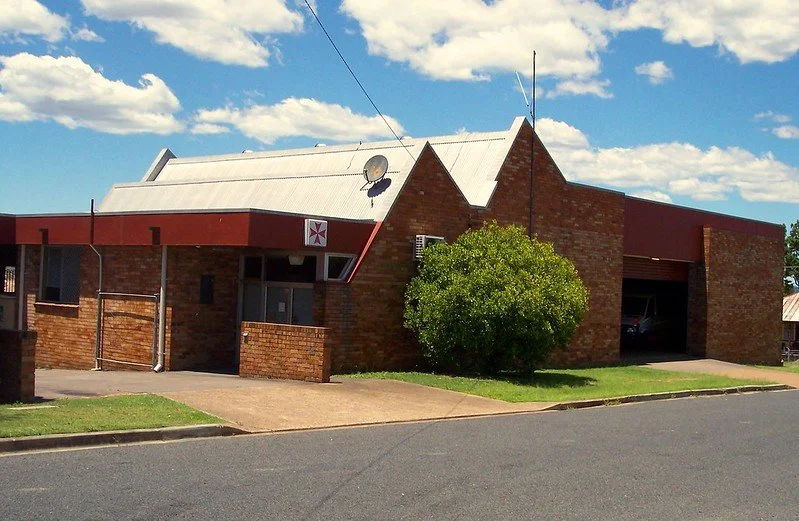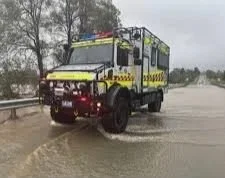Origins and development of the Ambulance Service in Maitland
The first ambulance service in New South Wales, apart from those operated by hospitals, was established in 1895 under the name of the Civil Ambulance and Transport Brigade (CATB). Its station was in borrowed police premises located in Sydney’s Railway Square and its vehicles were horse-drawn, the first motor vehicles not being obtained until 1912. These large cars were provided not by the government but through public donations as was to be the case for many years. The CATB’s first station had a staff of two.
Origins and early development in Maitland
The Maitland Hospital had an ambulance service, operated under contract, from 1890, but there were no motorised ambulances or any dedicated operational centre until 1924. Before then, the service consisted of a single horse-drawn ambulance wagon. Thomas Judge held the contract for about 30 years until his death in 1922: he housed the hospital’s wagon, supplied and looked after the horses, and responded to requests for ambulance assistance and to transport doctors to the sites of accidents. Judge also advised the Hospital on the acquisition of new ambulance vehicles.
The first Maitland District Ambulance Brigade station was in an existing building at 287 High St, on the corner of Albert (now Grant) and High streets, which was later known as Martin’s Corner. This was the site which from 1980 to 2022 housed the Maitland City Council’s now disused administration centre.
The site had been built upon since at least the 1850s, when a brick building with an iron roof was erected. This building had been occupied by a signwriter, a tobacconist, a grocery store and possibly other uses. In 1910 a replacement building was constructed for the Maitland Co-operative store, and that building was leased by the infant ambulance brigade in 1924. Numerous alterations had to be made to suit its new purpose.
The original Maitland Ambulance station building on the High St-Albert St corner with the Buick six vehicles, about 1924.
Supt H Guy and TJ Martin
Further photos of the original Ambulance Station and vehicles, 1920s
(Picture Maitland)
click on images for larger views
Initially there were two large cars, Buick Sixes, obtained from America by public subscription. A third vehicle was added within the first year of the brigade’s operation. On an inside wall of the building was a motto: ‘Ready Always’.
The Maitland Ambulance’s telephone number, 686, was prominently displayed on the building’s awning. The telephone service had been established in Maitland nearly 40 years before, but the fact that the number was of only three digits shows that there was as yet no huge list of subscribers. The words ‘DAY OR NIGHT’ next to the number emphasised the all-hours emergency function the ambulance represented.
In 1928 a purpose-built brick structure designed by Walter Pender was opened next door at 285 High St. This building was contracted for £5825/10-. It had space for eight cars, a repair and washing area, the superintendent’s office, a waiting room, a casualty room, three bedrooms, a staff recreation room, a kitchenette and space at the rear for expansion. Upstairs was the superintendent’s residence.
The new Ambulance Station at 285 High St, about 1929
Reproduced on the front cover of the 7th Annual Report and Financial Statement for the Maitland Ambulance Service.
Further photos of the new ambulance station, 1950s
(Picture Maitland)
click on above images for larger views
The new building’s foundation stone was laid by Sir Henry Braddon, a businessman, financier and diplomat, not by the state Governor or a senior politician such as the Premier. This signalled the fact that the station had not been funded by the state government. The opening ceremony was held before a formal luncheon in the Grand Junction Hotel, near Maitland Station, and a civic reception in the Town Hall.
Henry Braddon, 1918
As always for such functions, a large crowd was in attendance for the laying of the stone and the numerous accompanying speeches. Obtaining an ambulance station would have been seen by Maitland people as a sign of progress for their town.
To get to the point of establishing the station much apathy, cynicism and opposition had to be overcome. The combined population of West Maitland, East Maitland and Morpeth was only about 12,000 in the mid-1920s, and growth was slow: this was a period in which Maitland’s economy was in a rather moribund state. Maitland had lost its role as a major regional centre to the emerging industrial powerhouse of Newcastle, and government investment in community facilities was going increasingly to the coastal city.
Those who lobbied for an ambulance in Maitland took some time even to establish an enabling committee. Legend has it that the first donation to the committee was from a group of girls from the East Maitland Junior Red Cross who, in 1923, raised £4/14/6 for the cause.
Late in the same year the first Superintendent, HE Guy (previously the second-in-charge at the Newcastle station) was appointed. A committee of ten under the chairmanship of TF Cooney was established to advise him.
In 1927 a ‘Back to Maitland’ Week was held, the proceeds going to the local ambulance service. The state government was not yet on board in supporting the development of ambulance stations: local committees led the way in campaigns to raise the money to build them. Over the four years to 1928 a total of £17,000 was raised for the Maitland station, its vehicles and personnel, much of it thanks to the activities of the ‘Back to Maitland’ Week’. The fund-raising committee in 1927 was headed by the Mayor of West Maitland, Henry W Fry, with Cooney the vice-chairman and other prominent members of the community involved. A Ladies’ Committee, also involved in organising the Week’s activities, was chaired by Fry’s wife, the Lady Mayoress.
Front page of the Back to Maitland booklet
For more details visit Val Rudkin, ‘Back to Maitland 1925’, Maitland: Our Place, Our Stories, 19 April 2022.
People in the inter-war years subscribed to ambulance stations. Mining lodges made contributions, which covered their workers, and some businesses did likewise to cover staff members. For some working-class Maitland people, too, the ambulance station was a first port of call in the treatment of minor injuries like cuts and broken bones: doctors’ callouts were expensive and ambulance staff could provide assessments and, if necessary, ferry the injured to hospital.
The opening of the station in early 1929 was carried out in front of a few hundred people. Cooney was disappointed in the size of the crowd: he thought this was a “red-letter day” for Maitland and more of Maitland’s residents should have witnessed the occasion.
This station was to serve a population of about 45,000 comprising West Maitland, East Maitland, Morpeth and surrounding areas, and there were also ‘branch’ units (for example at Dungog). With Newcastle also having an ambulance station, the entire lower Hunter was covered.
Recent Times
Rutherford Ambulance Station, November 1973
The High St station served until 1973 when it was relocated to Walter St, Rutherford. Probably this was to escape the increasing congestion of the narrow High St and its many coal trucks which were distinctly unconducive to efficient ambulance operation. In addition the move took the station away from the perils of the floodplain: the original site had been inundated at least four times since 1924 - in 1930, 1949, 1952 and 1955. In 1955 the water in the station was well over a metre deep at the peak of the flood. Bad floods like these had the potential to paralyse ambulance operations or at least to seriously compromise their functioning at times of heightened demand.
Beyond High St, floods that are not especially large can threaten road access from the western and central parts of Maitland to the new Maitland Hospital at Metford. This can create serious problems for the Ambulance Service.
The levees built along the riverbank and around South Maitland since the late 1950s have largely kept floodwaters out of the built-up area apart from those caused by local rain. It must be noted, though, that Maitland has not experienced a flood anything like as large as the flood of 1955 in the intervening years. Yet such a flood, or an even bigger one, must be regarded as inevitable at some stage in the future.
In 2019 the station went to its present site on Aberglasslyn Rd, Rutherford. Today it is one of about 240 stations operated by the government-funded NSW Ambulance Service around the state. Its 43 paramedics and eight ambulances serve the entire Maitland City Council area. In 2025 a Hazardous Area Rescue Ambulance was acquired: this vehicle can operate in water up to 1.2 metres deep, has a reinforced exoskeleton to protect against falling trees and has burn-over crew protection for bush fire operations as well. The fact that the Maitland HARA is one of only eight such vehicles in the state attests to the significance of the flood problem in and around Maitland.
The Hazardous Area Rescue Ambulance
(NSW Ambulance)
References
‘Ambulance Station’, Maitland Daily Mercury, 15 September 1928.
Bone, Steve, personal communication.
‘Horse-drawn ambulances’, A Conspicuous Object: The Maitland Hospital, 23 January 2022.
Keys, Chas, ‘Our past: the development of the Ambulance Service in Maitland’, Maitland Mercury, 4 July 2025.
Mayhew, Joel, personal communication.
Rudkin, Val, ‘Back to Maitland 1925’, Maitland: Our Place, Our Stories, 19 April 2022.
Smith, Peter F, Maitland’s Rise: the Hill, the High Road and the River Flats, the author, 2023.
‘World first ambulance for Rutherford: HARA vehicles to improve flood response’, Maitland Mercury, 11 October 2024.




